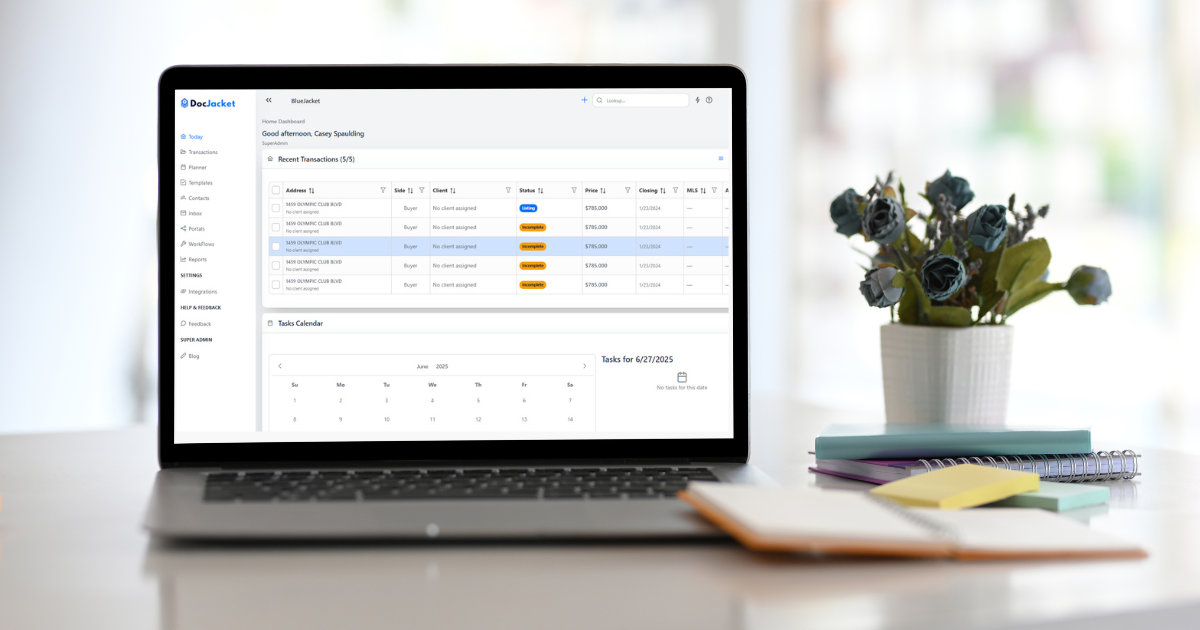Let’s be honest: real estate transactions can feel like juggling flaming torches while riding a unicycle. Between offers, inspections, loan approvals, and closing logistics, it’s easy for one crucial form or disclosure to slip through the cracks—often at the worst possible moment. As a Transaction Coordinator, you’re the peacekeeper, the checklist champion, and the one who makes sure every “i” is dotted and every “t” is crossed. That’s why I’ve put together this Red Flag Compliance Cheat Sheet. It’s a single-page, at-a-glance guide to the top seven most-missed disclosures and forms, plus their exact deadlines. Print it, pin it, carry it in your binder, or keep it up on your screen—whatever keeps it front and center. Run through it before any agent or broker check-in, and you’ll save yourself and your clients hours of last-minute scrambling. — ## Why Compliance Matters More Than Ever 1. Regulatory Risks Every state has its own timelines and requirements. Missing one disclosure might mean fines, penalties, or even license reviews. In tight-margin deals, a small slip can cut deeply into your commission or reputation. 2. Client Trust Buyers and sellers expect you to handle the paperwork so they can focus on packing boxes, moving logistics, or house hunting. When a missing form pops up two days before closing, you’re the one on the hook to fix it—often racing against the clock. 3. Smooth Closings A hiccup in compliance almost always delays funding. That means frustrated clients, annoyed lenders, and more work for you. Seal up the paperwork early, and you’ll glide into closing day with a victory lap instead of a panic sprint. By building compliance into your daily ritual—rather than letting it be an afterthought—you free up mental bandwidth for bigger-picture tasks: growing your network, refining your processes, or simply taking a breath. — ## The Cheat Sheet at a Glance | Disclosure / Form | When It’s Due | | ------------------------------------ | ------------------------------------------------------------- | | 1. Seller’s Property Disclosure | Within 3 days of contract acceptance | | 2. Lead-Based Paint Addendum | Immediately upon contract for homes built pre-1978 | | 3. HOA / Condo Docs | Within 5 business days of buyer’s request | | 4. EMD Receipt | Within 3 business days of contract | | 5. Inspection Contingency Notice | By the end of inspection period (e.g. Day 10) | | 6. Loan Estimate (GFE) | Lender must deliver within 3 business days of application | | 7. Closing Disclosure (CD) | At least 3 business days before scheduled closing | > Tip: Download a printable PDF version here: > Download the “Red Flag” Compliance Cheat Sheet (PDF) — ### 1. Seller’s Property Disclosure Deadline: Within 3 days of contract acceptance Most missed because: Agents sometimes forget to trigger it immediately once the buyer’s offer is accepted. * What it is: A comprehensive form detailing known defects or issues with the property—foundation cracks, roof leaks, pest problems, etc. * Why it matters: Buyers rely on this to decide whether to move forward, negotiate repairs, or walk away. * Best practice: * Send the blank disclosure form to the seller the moment you upload the ratified contract. * Set an internal alert for Day 2: if it’s not back, ping the seller or their agent with a friendly reminder. * Store a “Received” date on your worksheet so you can prove you delivered it on time. — ### 2. Lead-Based Paint Addendum Deadline: Immediately at contract for homes built pre-1978 Most missed because: It only applies to older homes, and sometimes agents forget which properties fall into that category. * What it is: A federal requirement that buyers receive information on potential lead hazards, sign an addendum, or waive their right. * Why it matters: Violations can lead to EPA fines and even undo closings if buyers aren’t properly informed. * Best practice: * Maintain a quick reference list of local building permit dates or a GIS overlay to flag any homes built before 1978. * Add a checkbox in your onboarding “deal intake” so it’s only triggered for qualifying properties. * Follow up with a phone call if you haven’t gotten the signed form back in 24 hours—it’s that critical. — ### 3. HOA / Condo Documents Deadline: Within 5 business days of buyer’s written request Most missed because: Buyers often request these verbally or late, and timelines get muddled. * What it is: Covenants, Conditions & Restrictions (CC&Rs), budget reports, meeting minutes, and financial statements for homeowner associations. * Why it matters: Buyers need these to assess fees, special assessments, and community rules. Lenders often require proof that the HOA is in good financial standing. * Best practice: * Automatically generate an email template that goes to the HOA management company as soon as you receive a buyer’s request. * Mark the incoming request date on your project board and set a 5-business-day countdown. * If the HOA doesn’t respond with a package by Day 3, escalate to a phone call—these docs have to move. — ### 4. Earnest Money Deposit (EMD) Receipt Deadline: Typically within 3 business days of contract Most missed because: Funds often come in days after signatures, and receipts get lost in inboxes. * What it is: Official acknowledgment that the buyer’s deposit has been received and deposited into escrow or a trust account. * Why it matters: Protects you and the seller by proving funds are secure. Without it, deadlines for contingencies can become ambiguous. * Best practice: * Confirm wire or check receipt with escrow/title company and request a stamped receipt. * Log the receipt date right next to your contract execution date so you can correlate contingency deadlines accurately. * Share a copy of the receipt with both buyer and seller via email and your transaction portal. — ### 5. Inspection Contingency Notice Deadline: By the end of the inspection period (e.g., Day 10) Most missed because: Dates shift and everyone assumes “the others” will handle it. * What it is: Written notice from the buyer indicating whether they accept the property “as-is,” request repairs, or cancel the contract. * Why it matters: Triggers the next phase (repair negotiations or removal of contingency) and protects both sides legally. * Best practice: * Send a calendar invitation to the buyer and agent at contract signing with a reminder on Day 8 to gather feedback. * Draft the standard “Inspection Response” template ahead of time so you can fill in details quickly. * File the signed notice immediately and send copies to all parties—no back-and-forth dribbles. — ### 6. Loan Estimate (Good Faith Estimate) Deadline: Within 3 business days of loan application Most missed because: It’s controlled by the lender, and clients sometimes assume you’ll chase it. * What it is: A standardized form lenders must provide showing estimated interest rate, closing costs, and monthly payments. * Why it matters: Buyers need this to budget for closing, and it’s critical for mortgage compliance (Truth in Lending Act). * Best practice: * Add a “Loan Estimate Due” line item in your tracking sheet upon loan application. * At Day 2, send a gentle nudge to the lender: “Just checking in on the LE for [Buyer Name].” * Confirm the LE arrival date so you can calculate the 10-day waiting period before final disclosures. — ### 7. Closing Disclosure (CD) Deadline: At least 3 business days before scheduled closing Most missed because: CDs often arrive late or with errors, risking last-minute revisions that can delay funding. * What it is: The final breakdown of actual closing costs, loan terms, and funds required to close. * Why it matters: Federal law requires a minimum three-day review period. If changes exceed certain thresholds, a new three-day clock resets. * Best practice: * Flag a “CD Due” reminder on your calendar as soon as the lender notifies you of an anticipated closing date. * On Day 2 of your countdown, review the CD line-by-line against the Loan Estimate and title documents for discrepancies. * If any numbers changed by more than allowed tolerance, alert the lender immediately—better caught now than at signing. — ## Putting It All Together Think of this cheat sheet as your safety net. Before every weekly status call or ad-hoc check-in, run through the seven red flags: 1. Seller’s Property Disclosure 2. Lead-Based Paint Addendum 3. HOA / Condo Docs 4. EMD Receipt 5. Inspection Contingency Notice 6. Loan Estimate 7. Closing Disclosure Spend 60 seconds ticking off each box. You’ll catch missing items early, keep agents and clients in the loop, and sail into closing day with confidence. > Grab the printable PDF to slip into your binder or post over your desk: > Download the “Red Flag” Compliance Cheat Sheet (PDF) When you make compliance a simple habit, you become not just a TC, but a deal-maker’s secret weapon. Happy closing!
Loading Articles...
Just a moment.





